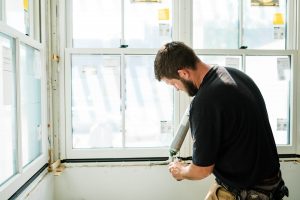Top Tips for How to Replace a Window Without Removing the Siding
Feb 18, 2025You can learn how to replace a window without removing the siding by using insert windows. This guide will cover the tools needed, step-by-step instructions, and tips for a successful installation.
Key Takeaways
- Use tools like a tape measure, caulk, and a pry bar to replace windows without damaging siding.
- For a successful installation, follow a three-step process: prepare the frame, remove the old window, and install the replacement.
- Consider hiring professionals for older homes due to potential lead paint issues and to ensure a proper job, especially during siding projects.
Essential Tools for Replacing Windows Without Removing Siding
Replacing windows without removing the siding requires the right tools. Accurate measurements with a tape measure ensure the new window fits perfectly, avoiding gaps that can lead to drafts and water leaks.
Caulk is necessary to seal gaps and ensure a weather-tight installation, maintaining your home’s energy efficiency. A utility knife is also useful for trimming materials, providing a clean and professional finish.
A pry bar is indispensable for removing the old window without damaging the surrounding area. Equipped with these tools, you can replace your windows without removing the siding, saving time and preserving your home’s exterior.
Step-by-Step Guide to Replacing a Window Without Siding Removal

Replacing a window without removing the siding involves an insert or pocket window installation. This method fits new replacement windows into the existing frame, offering a less invasive alternative to full-frame replacements to replace a window.
The process consists of three main steps: preparing the existing frame, removing the old window, and installing the replacement. Each step is essential for a smooth and successful window replacement. Examining each step in detail ensures a clear understanding of the process.
Preparing the Existing Window Frame
Before starting, ensure the existing window frame is ready for the new window. Inspect the frame and sill for rot or mold and address any issues you find to prevent the new installation from being compromised.
Ensure the frame is in good condition and capable of supporting the new window, providing necessary support for a lasting fit. Once confirmed, proceed to the next step.
Removing the Old Window
Removing the old window requires careful handling to avoid damaging the surrounding siding. Carefully cut and peel back the siding around the window to access the interior trim without damaging it.
Remove the interior trim to expose the window frame. Unscrew the fasteners holding the old window sashes and gently remove them. Taking your time ensures the old window is removed without harming the existing siding.
Installing the Replacement Window
After removing the old window, install the replacement. Ensure the new window is level and square in the existing frame, checking for level and plumb during installation.
Fill any gaps between the new window and the existing frame with trim pieces to ensure a snug fit and maintain energy efficiency. Once the window is securely in place, proceed with sealing and finishing touches.
Impact on Existing Trim and Siding
Preserve your home’s exterior and reduce labor costs by replacing windows without removing the siding. This method is less invasive and retains the existing look of your siding.
Full-frame window replacements remove both the window unit and trim, which can be more expensive and labor-intensive. Insert replacements often leave the trim intact, minimizing disruption and preserving decorative trim.
Replacing windows can affect the size, shape, or configuration of your vinyl siding. Different materials like vinyl and steel require specific considerations for installation. Keeping these factors in mind ensures a seamless and aesthetically pleasing replacement.
Benefits of Using Replacement Windows
Replacement windows offer numerous benefits, making them popular among homeowners. One significant advantage is improved energy efficiency, reducing heating and cooling costs and making your home more comfortable and energy efficient.
Beyond energy savings, replacement windows enhance your home’s aesthetic appeal by allowing more natural light, improving mood, and reducing reliance on artificial lighting. Vinyl windows, in particular, balance functionality and affordability.
Replacing old windows with new windows can also reduce noise pollution, creating a more tranquil indoor environment. Upgrading your windows improves energy efficiency, appearance, and overall comfort.
DIY Tips for Window Replacement
For DIY enthusiasts, replacing windows can be rewarding. Clean the window opening with a shop vacuum to remove dust and debris, ensuring a proper fit and seal. Accurate measurements are crucial. Measure the window opening at multiple points to ensure a perfect fit. Use shims to level the sill and apply flashing tape for a waterproof seal before installation.
After placing the window, fill any gaps with spray foam insulation to prevent leaks. Ensure the new window operates smoothly and make necessary adjustments with shims. Following these tips ensures a professional-quality installation.
Potential Issues with Improper Installation

Improper window installation can lead to leaks, drafts, and structural damage, causing mold growth, rot, and significant damage over time. Promptly replacing leaking windows prevents further escalation.
To avoid these problems, properly secure the new window with flashing and caulking to prevent leaks and ensure airtightness. Caulking around the edges seals gaps and prevents drafts.
Difficulty operating the windows can result from incorrect installation, leading to air and water leaks. Correct window installation is crucial to avoid serious long-term issues.
When to Consider Professional Help
While DIY window replacement can be rewarding, professional help is advisable for homes built before 1978, as they may have lead paint requiring special handling to replace windows.
Coordinating window replacement with a full siding replacement project prevents extra costs associated with moisture barriers and capping. If your budget allows, hire professionals to ensure both tasks are done correctly and simultaneously.
Summary
Replacing windows without removing siding is a practical and efficient way to upgrade your home. By following this step-by-step guide and using the right tools, you can achieve a successful window replacement that enhances your home’s energy efficiency and aesthetic appeal.
Whether you tackle the project yourself or hire professionals, understanding the process and potential issues will help you make informed decisions. Enjoy the benefits of improved insulation, reduced energy bills, and a more comfortable living space with your new replacement windows.






